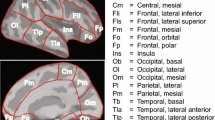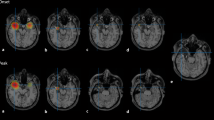Abstract
Precise identification of epileptogenic zones in patients with intractable drug-resistant epilepsy is critical for successful epilepsy surgery. Numerous source-imaging algorithms for localizing epileptogenic zones based on scalp electroencephalography (EEG) and magnetoencephalography (MEG) have been developed and validated in simulation and experimental studies. Recently, intracranial EEG (iEEG)-based imaging of epileptogenic sources has attracted interest as a promising tool for presurgical evaluation of epilepsy; however, most iEEG studies have focused on localization of epileptogenic zones in focal epilepsy. In the present study, we investigated whether iEEG source imaging is a useful supplementary tool for identifying extended epileptogenic sources in secondary generalized epilepsy such as Lennox-Gastaut syndrome (LGS). To this end, we applied four different cortical source imaging algorithms, namely minimum norm estimation (MNE), low-resolution electromagnetic tomography (LORETA), standardized LORETA (sLORETA), and L p -norm estimation (p = 1.5, referred to as Lp1.5), to artificial iEEG datasets generated assuming various source sizes and locations. We also applied these four algorithms to clinical ictal iEEG recordings acquired from a pediatric patient with LGS. Interestingly, the traditional MNE algorithm outperformed the other imaging algorithms in most of our experiments, particularly in cases when larger-sized sources were activated. Although sLORETA outperformed both LORETA and Lp1.5, its performance was not as good as that of MNE. Compared to the other algorithms, the performance of Lp1.5 decayed most rapidly as the source size increased. Our findings suggest that iEEG source imaging using MNE is a promising auxiliary tool for the identification of epileptogenic zones in secondary generalized epilepsy. We anticipate that our results will provide useful guidelines for selection of an appropriate imaging algorithm for iEEG source imaging studies.









Similar content being viewed by others
References
Aghakhani Y, Bagshaw AP, Benar CG, Hawco C, Andermann F, Dubeau F et al (2004) fMRI activation during spike and wave discharges in idiopathic generalized epilepsy. Brain 127:1127–1144
Archer JS, Abbott DF, Waites AB, Jackson GD (2003) fMRI “deactivation” of the posterior cingulate during generalized spike and wave. NeuroImage 20:1915–1922
Babiloni F, Babiloni C, Carducci F, Romani GL, Rossini PM, Angelone LM, Cincotti F (2003) Multimodal integration of high-resolution EEG and functional magnetic resonance imaging data: a simulation study. NeuroImage 19:1–15
Babiloni F, Cincotti F, Babiloni C, Carducci F, Mattia D, Astolfi L, Basilisco A, Rossini PM, Ding L, Ni Y, Cheng J, Christine K, Sweeney J, He B (2005) Estimation of the cortical functional connectivity with the multimodal integration of high-resolution EEG and fMRI data by directed transfer function. NeuroImage 24:118–131
Bai X, Towle VL, He EJ, He B (2007) Evaluation of cortical current density imaging methods using intracranial electrocorticograms and functional MRI. NeuroImage 35:598–608
Bai X, Vestal M, Berman R, Negishi M, Spann M, Vega C, DeSalvo MN, Novotny E, Constable RT, Blumenfeld H (2010) Dynamic timecourse of typical childhood absence seizures: EEG, behavior and fMRI. J Neurosci 30:5884–5893
Behrens E, Zentner J, Van Roost D, Hufnagel A, Elger CE, Schramm J (1994) Subdural and depth electrodes in the presurgical evaluation of epilepsy. Acta Neurochir 128:84–87
Berman R, Negishi M, Spann M, Chung MH, Bai X, Purcaro M, Motelow JE, DixCooper L, Enev M, Novotny EJ, Constable RT, Blumenfeld H (2010) Simultaneous EEG, fMRI, and behavioral testing in typical childhood absence seizures. Epilepsia 51:2011–2022
Binnie CD, Elwes RDC, Polkey CE, Volans A (1994) Utility of stereoelectroencephalography in preoperative assessment of temporal lobe epilepsy. J Neurol Neurosurg Psychiatry 57:58–65
Dale AM, Sereno MI (1993) Improved localization of cortical activity by combining EEG and MEG with MRI cortical surface reconstruction: a linear approach. J Cogn Neurosci 5:162–176
Dale AM, Liu AK, Fischl BR, Buckner RL, Belliveau JW, Lewine JD, Halgren E (2000) Dynamic statistical parametric mapping: combining fMRI and MEG for high-resolution imaging of cortical activity. Neuron 26:55–67
Dubeau F, McLachlan RS (2000) Invasive electrographic recording techniques in temporal lobe epilepsy. Can J Neurol Sci 27:S29–S34
Dümpelmann M, Fell J, Wellmer J, Urbach H, Elger CE (2009) 3D source localization derived from subdural strip and grid electrodes: a simulation study. Clin Neurophysiol 120:1061–1069
Fuchs M, Wagner M, Köhler T, Wischmann HA (1999) Linear and nonlinear current density reconstructions. J Clin Neurophysiol 16:267–295
Fuchs M, Wagner M, Kastner J (2007) Development of volume conductor and source models to localize epileptic foci. J Clin Neurophysiol 24:101–119
Gotman J, Grova C, Bagshaw A, Kobayshi E, Aghakhani Y, Dubeau F (2005) Generalized epileptic discharges show thalamocortical activation and suspension of the default state of the brain. Proc Natl Acad Sci USA 102:15236–15240
Grova C, Daunizeau J, Lina JM, Bénar CG, Benali H, Gotman J (2006) Evaluation of EEG localization methods using realistic simulations of interictal spikes. NeuroImage 29:734–753
Heiskala H (1997) Community-based study of lennox-gastaut syndrome. Epilepsia 38:526–531
Im CH, An KO, Jung HK, Kwon H, Lee YH (2003) Assessment criteria for MEG/EEG cortical patch tests. Phys Med Biol 48:2561–2573
Kim YK, Lee DS, Lee SK, Chung CK, Chung JK, Lee MC (2002) 18F-FDG PET in localization of frontal lobe epilepsy: comparison of visual and SPM analysis. J Nucl Med 43:1167–1174
Kim JS, Im CH, Jung YJ, Kim EY, Lee SK, Chung CK (2010) Localization and propagation analysis of ictal source rhythm by electrocorticography. NeuroImage 52:1279–1288
Kincses WE, Braun C, Kaiser S, Elbert T (1999) Modeling extended sources of event-related potentials using anatomical and physiological constraints. Hum Brain Mapp 8:182–193
Krakow K, Woermann FG, Symms MR, Allen PJ, Lemieux L, Barker GJ, Duncan JS, Fish DR (1999) EEG-triggered functional MRI of interictal epileptiform activity in patients with partial seizures. Brain 122:1679–1688
Lee YJ, Kang HC, Lee JS, Kim SH, Kim DS, Shim KW, Lee YH, Kim TS, Kim HD (2010) Resective pediatric epilepsy surgery in Lennox-Gastaut syndrome. Pediatrics 125:e58–e66
Liu AK, Dale AM, Belliveau JW (2002) Monte Carlo simulation studies of EEG and MEG localization accuracy. Hum Brain Mapp 16:47–62
Liu H, Schimpf PH, Dong G, Gao X, Yang F, Gao S (2005) Standardized shrinking LORETA-FOCUSS (SSLOFO): a new algorithm for spatio-temporal EEG source reconstruction. IEEE Trans Biomed Eng 52:1681–1691
Michel CM, Murray MM, Lantz G, Gonzalez S, Spinelli L, Grave De Peralta R (2004) EEG source imaging. Clin Neurophysiol 115:2195–2222
Nunez PL, Srinivasan R (2006) Electric fields of the brain: the neurophysics of EEG. Oxford University Press, New York
Oliveira AJ, Da Costa JC, Hilário LN, Anselmi OE, Palmini A (1999) Localization of the epileptogenic zone by ictal and interictal SPECT with 99mTc-ethyl cysteinate dimer in patients with medically refractory epilepsy. Epilepsia 40:693–702
Oostendorp TF, Delbeke J, Stegeman DF (2000) The conductivity of the human skull: results of in vivo and in vitro measurements. IEEE Trans Biomed Eng 47:1487–1492
Pascual-Marqui RD (2002) Standardized low-resolution brain electromagnetic tomography (sLORETA): technical details. Methods Find Exp Clin Pharmacol 24(Suppl D):5–12
Pascual-Marqui RD, Michel CM, Lehmann D (1994) Low resolution electromagnetic tomography: a new method for localizing electrical activity in the brain. Int J Psychophysiol 18:49–65
Plummer C, Wagner M, Fuchs M, Vogrin S, Litewka L, Farish S, Bailey C, Harvey AS, Cook MJ (2010) Clinical utility of distributed source modelling of interictal scalp EEG in focal epilepsy. Clin Neurophysiol 121:1726–1739
Pondal-Sordo M, Diosy D, Téllez-Zenteno JF, Sahjpaul R, Wiebe S (2007) Usefulness of intracranial EEG in the decision process for epilepsy surgery. Epilepsy Res 74:176–182
Rosenow F, Lüders H (2001) Presurgical evaluation of epilepsy. Brain 124:1683–1700
Salek-Haddadi A, Lemieux L, Merschhemke M, Friston K, Duncan J, Fish D (2003) Functional magnetic resonance imaging of human absence seizures. Ann Neurol 53:663–667
Surazhsky V, Surazhsky T, Kirsanov D, Gortler SJ, Hoppe H (2005) Fast exact and approximate geodesics on meshes. ACM Trans Graph 24:553–560
Wang JZ, Williamson SJ, Kaufman L (1992) Magnetic source images determined by a lead-field analysis: the unique minimum-norm least-squares estimation. IEEE Trans Biomed Eng 39:665–675
Wilke C, Van Drongelen W, Kohrman M, He B (2010) Neocortical seizure foci localization by means of a directed transfer function method. Epilepsia 51:564–572
Wischmann HA, Fuchs M, Dössel O (1992) Effect of the signal-to-noise ratio on the quality of linear estimation reconstructions of distributed current sources. Brain Topogra 5:189–194
Wu JY, Sutherling WW, Koh S, Salamon N, Jonas R, Yudovin S, Sankar R, Shields WD, Mathern GW (2006) Magnetic source imaging localizes epileptogenic zone in children with tuberous sclerosis complex. Neurology 66:1270–1272
Wyllie E, Lachhwani DK, Gupta A, Chirla A, Cosmo G, Worley S, Kotagal P, Ruggieri P, Bingaman WE (2007) Successful surgery for epilepsy due to early brain lesions despite generalized EEG findings. Neurology 69:389–397
Yao J, Dewald JPA (2005) Evaluation of different cortical source localization methods using simulated and experimental EEG data. NeuroImage 25:369–382
Zhang YC, Ding L, van Drongelen W, Hecox K, Frim DM, He B (2006) A cortical potential imaging study from simultaneous extra- and intracranial electrical recordings by means of the finite element method. NeuroImage 31:1513–1524
Zhang YC, van Drongelen W, Kohrman M, He B (2008) Three-dimensional brain current source reconstruction from intra-cranial ECoG recordings. NeuroImage 42:683–695
Acknowledgments
This work was supported by a grant of the Korea Healthcare Technology R&D Project, Ministry for Health, Welfare & Family Affairs, Republic of Korea (A090579-0901-0000201).
Author information
Authors and Affiliations
Corresponding author
Additional information
Jae-Hyun Cho and Seung Bong Hong contributed equally to this study (co-first authors).
Electronic supplementary material
Below is the link to the electronic supplementary material.
Rights and permissions
About this article
Cite this article
Cho, JH., Hong, S.B., Jung, YJ. et al. Evaluation of Algorithms for Intracranial EEG (iEEG) Source Imaging of Extended Sources: Feasibility of Using iEEG Source Imaging for Localizing Epileptogenic Zones in Secondary Generalized Epilepsy. Brain Topogr 24, 91–104 (2011). https://doi.org/10.1007/s10548-011-0173-2
Received:
Accepted:
Published:
Issue Date:
DOI: https://doi.org/10.1007/s10548-011-0173-2




